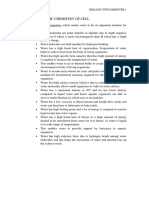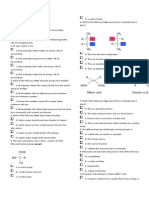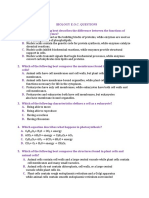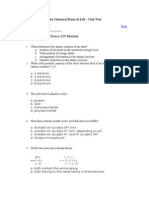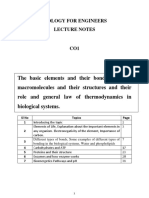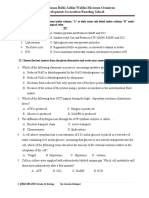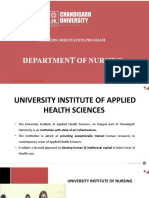Unit 2 Chemical Basis of Life Review
Unit 2 Chemical Basis of Life Review
Uploaded by
Kamal NaserCopyright:
Available Formats
Unit 2 Chemical Basis of Life Review
Unit 2 Chemical Basis of Life Review
Uploaded by
Kamal NaserOriginal Description:
Copyright
Available Formats
Share this document
Did you find this document useful?
Is this content inappropriate?
Copyright:
Available Formats
Unit 2 Chemical Basis of Life Review
Unit 2 Chemical Basis of Life Review
Uploaded by
Kamal NaserCopyright:
Available Formats
Name: _________________________________
Unit 2 – Chemical Basis for Life
1. What does it mean for a compound to be organic?
2. Circle: Water is polar / nonpolar because the electrons are not evenly shared.
3. List three important properties of water that result from the above characteristic and describe why they are
important to life.
a.
b.
c.
4. What is the difference between a monomer and polymer?
5. Compounds that contain the element carbon are called _______________ compounds. Why is carbon able
to form such a wide variety compounds?
6. Circle: Dehydration synthesis adds / removes water to ________ a bond, while hydrolysis adds / removes
water to _________ a bond.
6. Carbohydrates have a ___: ___: ___ ratio of the elements C:H:O. Carbohydrates are the main
______________ source for a cell.
7. Amino acids (the monomers of a protein) are made up of what three parts?
a.
b.
c.
8. How do enzymes act as biological catalysts?
9. Complete the Biomolecule Review Chart Below:
Macromolecule Elements Monomer /Polymers Roles inside of cells
Carbohydrates 1C:2H:1O
Lipids NA; Triglyeride = glycerol
& 3 fatty acid tails
Proteins Amino Acids /
polypeptides or proteins
Nucleic Acids Store & transmit genetic
info; ATP
10. Which statement best describes an effect of the low density of frozen water in a lake?
A. When water freezes, it contracts, decreasing the water level in a lake.
B. Water in a lake freezes from the bottom up, killing most aquatic organisms.
C. When water in a lake freezes, it floats, providing insulation for organisms below.
D. Water removes thermal energy from the land around a lake, causing the lake to freeze.
11. Which statement correctly describes how carbon’s ability to form four bonds makes it uniquely suited
to form macromolecules?
A. It forms short, simple carbon chains.
B. It forms large, complex, diverse molecules.
C. It forms covalent bonds with other carbon atoms.
D. It forms covalent bonds that can exist in a single plane.
12. Use the diagram on the right to answer the question.
The diagram shows a reaction that forms a polymer
from two monomers. What is this type of reaction
called?
A. glycolysis
B. hydrolysis
C. photosynthesis
D. dehydration synthesis
13. Carbohydrates and proteins are two types of
macromolecules. Which functional characteristic of
proteins distinguishes them from carbohydrates?
A. large amount of stored information
B. ability to catalyze biochemical reactions
C. efficient storage of usable chemical energy
D. tendency to make cell membranes hydrophobic
14. Substance A is converted to substance B in a metabolic reaction. Which statement best describes the role
of an enzyme during this reaction?
A. It adjusts the pH of the reaction medium.
B. It provides energy to carry out the reaction.
C. It dissolves substance A in the reaction medium.
D. It speeds up the reaction without being consumed.
15. A scientist observes that, when the pH of the environment surrounding an enzyme is changed, the rate the
enzyme catalyzes a reaction greatly decreases. Which statement best describes how a change in pH can affect
an enzyme?
A. A pH change can cause the enzyme to change its shape.
B. A pH change can remove energy necessary to activate an enzyme.
C. A pH change can add new molecules to the structure of the enzyme.
D. A pH change can cause an enzyme to react with a different substrate.
17. Proteins are a major part of every living cell and have many different functions within each cell.
Carbohydrates also perform numerous roles in living things.
a. Describe the general composition of a protein molecule.
b. Describe how the structures of proteins differ from the structures of carbohydrates.
c. Describe how the functions of proteins differ from the functions of carbohydrates.
You might also like
- AP Biology Unit 1 TestDocument23 pagesAP Biology Unit 1 TestRishi m100% (4)
- Kamisama Kiss v07Document194 pagesKamisama Kiss v07JSA2343100% (1)
- Biology Chapter 1 STPM Sem1Document12 pagesBiology Chapter 1 STPM Sem1Jia Hui100% (5)
- Chapter 6 Practice TestDocument5 pagesChapter 6 Practice TestLogan ParkisonNo ratings yet
- MCQ On Numerical MethodsDocument5 pagesMCQ On Numerical MethodsMohd Salman100% (1)
- Questions On Mirrors and LensesDocument29 pagesQuestions On Mirrors and LensesKamal Naser100% (2)
- 3 Prep-First Term - ScienceDocument6 pages3 Prep-First Term - ScienceKamal NaserNo ratings yet
- CFM56 C PDFDocument1 pageCFM56 C PDFhamidrezachamani100% (1)
- Amigurumi Zebra Toy - Free Crochet Pattern: Olena's Crafts Original Pattern by Olena HuffmireDocument8 pagesAmigurumi Zebra Toy - Free Crochet Pattern: Olena's Crafts Original Pattern by Olena HuffmiremurkyNo ratings yet
- Honors Unit 2 Biochemistry Study Guide S23Document6 pagesHonors Unit 2 Biochemistry Study Guide S23realsteelwarredNo ratings yet
- Biology Keystone Exam ReviewDocument58 pagesBiology Keystone Exam ReviewLian LzNo ratings yet
- 1ST SA BIOCHEMISTRY - AlmendrasDocument5 pages1ST SA BIOCHEMISTRY - AlmendrasCherry DagohoyNo ratings yet
- Biochem Test PDFDocument3 pagesBiochem Test PDFketyleenbNo ratings yet
- Biology Keystone Module 1 PracticetestDocument5 pagesBiology Keystone Module 1 PracticetestTalia GelmanNo ratings yet
- 8 - Q1 Biology1Document16 pages8 - Q1 Biology1giannolakompakeNo ratings yet
- Unit 1 Practice Test (Spring 2012) - Answer Key (1)Document2 pagesUnit 1 Practice Test (Spring 2012) - Answer Key (1)allenownzgiveawayNo ratings yet
- Natural Phenomena Often Require An ExplanationDocument7 pagesNatural Phenomena Often Require An Explanationpmm23d177No ratings yet
- Vasquez, Angelica, Bio30lL, Activity 2,2020Document7 pagesVasquez, Angelica, Bio30lL, Activity 2,2020Angelica VasquezNo ratings yet
- Human Body Complied IAsDocument26 pagesHuman Body Complied IAsAfari Emmanuel debrahNo ratings yet
- Biochem TestADocument6 pagesBiochem TestAaby251188No ratings yet
- Immediate Download Test Bank For Molecular Biology of The Cell Sixth Edition All ChaptersDocument58 pagesImmediate Download Test Bank For Molecular Biology of The Cell Sixth Edition All Chaptersinolleziel100% (1)
- Homework_21-23Document6 pagesHomework_21-23eugeneasunNo ratings yet
- Exam1 2017v2finalDocument10 pagesExam1 2017v2finalsomon pierre GAHIMBARENo ratings yet
- Grade 11 - BiologyDocument6 pagesGrade 11 - BiologyHuy Nguyễn CôngNo ratings yet
- Output Sheet 2 - 1Document4 pagesOutput Sheet 2 - 1Cristine Kaye BandelanNo ratings yet
- A. Stanley MillerDocument14 pagesA. Stanley MillerCourtney JachnaNo ratings yet
- BemcqDocument1 pageBemcqJohn Andrew GonzalesNo ratings yet
- U1 CH 2 Biochem KeyDocument4 pagesU1 CH 2 Biochem KeynreedNo ratings yet
- Summative 2 Physical Science Answer KeyDocument2 pagesSummative 2 Physical Science Answer KeygjarandiaNo ratings yet
- Lehninger Multiple ChoiceDocument13 pagesLehninger Multiple ChoiceHugo DuarteNo ratings yet
- Biology E.O.C. Practice QuestionsDocument5 pagesBiology E.O.C. Practice QuestionsInfinite BeastNo ratings yet
- Reading Guides 2011Document142 pagesReading Guides 2011henrym1095100% (1)
- (Photosynthesis and Cellular Respiration) : What I Know (Pre Test)Document16 pages(Photosynthesis and Cellular Respiration) : What I Know (Pre Test)Maricar Feb MaturanNo ratings yet
- GenBio1 Week 5 Q2Document27 pagesGenBio1 Week 5 Q2Reygie Ann SuenoNo ratings yet
- The Chemical Basis of LifeDocument13 pagesThe Chemical Basis of Lifezulfikarleghari100% (1)
- How Cells Harvest Chemical Energy: Chapter ObjectivesDocument12 pagesHow Cells Harvest Chemical Energy: Chapter Objectivesirene9tan9ailianNo ratings yet
- Test Bank for Molecular Biology of the Cell Sixth Edition download pdfDocument59 pagesTest Bank for Molecular Biology of the Cell Sixth Edition download pdftuovickibortNo ratings yet
- 2ND Quarter General Biology 1 - FinalDocument2 pages2ND Quarter General Biology 1 - FinalAlice RiveraNo ratings yet
- Chemical Components of A CellDocument3 pagesChemical Components of A Cellapi-421872899No ratings yet
- Tutorial Study Guide: NSC 1110 - BiologyDocument14 pagesTutorial Study Guide: NSC 1110 - BiologyKalinda MondeNo ratings yet
- Full Download of Test Bank for Molecular Biology of the Cell Sixth Edition in PDF DOCX FormatDocument57 pagesFull Download of Test Bank for Molecular Biology of the Cell Sixth Edition in PDF DOCX Formatarmiolokite100% (3)
- Chemical Basis of Life: Key ConceptsDocument7 pagesChemical Basis of Life: Key ConceptsLove Mie MoreNo ratings yet
- LE1 MockExam PDFDocument8 pagesLE1 MockExam PDFAlexander Miguel SyNo ratings yet
- 2020 Midterm 1 Questions W AnswersDocument13 pages2020 Midterm 1 Questions W AnswersKingsley ZhengNo ratings yet
- Ch. 3 Molecules of Life Review-2008Document3 pagesCh. 3 Molecules of Life Review-2008Nopporn SaSaNo ratings yet
- Worksheet-BiomoleculesDocument2 pagesWorksheet-BiomoleculesanayatvirkNo ratings yet
- Quarter 1 Quiz ReviewerDocument125 pagesQuarter 1 Quiz ReviewermartgetaliaNo ratings yet
- Molecular BiologyDocument51 pagesMolecular Biologycandyli3788No ratings yet
- Revision Lecture Notes Biological Molecules: Chapter No-2Document17 pagesRevision Lecture Notes Biological Molecules: Chapter No-2Ãrêêbã ÅsĦfåqNo ratings yet
- The Basic Elements and Their Bonding Ability, Macromolecules and Their Structures and Their Role and General Law of Thermodynamics in Biological SystemsDocument40 pagesThe Basic Elements and Their Bonding Ability, Macromolecules and Their Structures and Their Role and General Law of Thermodynamics in Biological Systemsruchir 11No ratings yet
- Biology Combined NotesDocument166 pagesBiology Combined Notessanjana bishtNo ratings yet
- Unit 1 - Potential FRQsDocument4 pagesUnit 1 - Potential FRQs1669529No ratings yet
- Carbohydrates Worksheet..Document7 pagesCarbohydrates Worksheet..norhain4.aNo ratings yet
- GENBIO1 Activity SheetsDocument3 pagesGENBIO1 Activity SheetsKd123No ratings yet
- 1.8.1 Biochemistry Unit Test-New8by11Document7 pages1.8.1 Biochemistry Unit Test-New8by11Mushtaq Abdinasir DahirNo ratings yet
- Biochemistry Notes PDFDocument11 pagesBiochemistry Notes PDFChris_Barber0950% (6)
- Quarter 2 Module 1 General Biology 1 SCDocument31 pagesQuarter 2 Module 1 General Biology 1 SCAldrin James DafunNo ratings yet
- Biology Ch. 2 Review Questions KEY 1Document4 pagesBiology Ch. 2 Review Questions KEY 1ColeenNo ratings yet
- Biology Grade 12 PreparationDocument8 pagesBiology Grade 12 PreparationNafiyaf BerhanuNo ratings yet
- Bio Homework Week 1Document3 pagesBio Homework Week 1MaCayla Cole-BannerNo ratings yet
- Biological Molecules (AS Level Bio)Document35 pagesBiological Molecules (AS Level Bio)DrMufaddal RampurwalaNo ratings yet
- Photosynthesis Cell RespDocument3 pagesPhotosynthesis Cell RespKimeu BagyonNo ratings yet
- Biology Today and Tomorrow Without Physiology 5th Edition by Starr Evers ISBN Solution ManualDocument13 pagesBiology Today and Tomorrow Without Physiology 5th Edition by Starr Evers ISBN Solution Manualmichael100% (44)
- SUMMATIVE TEST-SCIENCE 9 (Photosynthesis & Cellular Respiration)Document3 pagesSUMMATIVE TEST-SCIENCE 9 (Photosynthesis & Cellular Respiration)lavenia acdal100% (2)
- Anatomy and Physiology: Chemistry and the Body: Things You Should Know (Questions and Answers)From EverandAnatomy and Physiology: Chemistry and the Body: Things You Should Know (Questions and Answers)No ratings yet
- B1.2.19 Distance and Displacement WorksheetDocument1 pageB1.2.19 Distance and Displacement WorksheetKamal NaserNo ratings yet
- 3prep First Term Revision Unit TwoDocument28 pages3prep First Term Revision Unit TwoKamal NaserNo ratings yet
- 3Prep-The First Term-Unit 3-The UniverseDocument5 pages3Prep-The First Term-Unit 3-The UniverseKamal NaserNo ratings yet
- 3prep FirstTerm Unit 2 LensesDocument12 pages3prep FirstTerm Unit 2 LensesKamal NaserNo ratings yet
- 3prep - FirstTerm-UnitTwoDocument18 pages3prep - FirstTerm-UnitTwoKamal NaserNo ratings yet
- Kamal Science 01115671119 3Prep-First Term-Unit One Physical QuantitiesDocument2 pagesKamal Science 01115671119 3Prep-First Term-Unit One Physical QuantitiesKamal NaserNo ratings yet
- Intelligence Community and Classified InformationDocument22 pagesIntelligence Community and Classified InformationKamal NaserNo ratings yet
- Past Simple Past ContinuousDocument21 pagesPast Simple Past ContinuousKamal NaserNo ratings yet
- Computer Assisted Learning - Analysis Through Multiple IntelligencesDocument31 pagesComputer Assisted Learning - Analysis Through Multiple IntelligencesKamal NaserNo ratings yet
- Past Simple Past ContinuousDocument21 pagesPast Simple Past ContinuousKamal NaserNo ratings yet
- Simple Present: QuestionsDocument29 pagesSimple Present: QuestionsKamal NaserNo ratings yet
- يوسف محمد الصحفي-عمليات العلم-انجليزيDocument3 pagesيوسف محمد الصحفي-عمليات العلم-انجليزيKamal NaserNo ratings yet
- P2201 Operating Instruction Manual: Low Velocity Powder Actuated Fastening ToolDocument32 pagesP2201 Operating Instruction Manual: Low Velocity Powder Actuated Fastening TooleguillenNo ratings yet
- Iec60243 1 2013Document58 pagesIec60243 1 2013bobby sarathogaNo ratings yet
- Kindun - The Desert KingdomDocument38 pagesKindun - The Desert Kingdomdizman021No ratings yet
- WomeninministryDocument34 pagesWomeninministryzaneleNo ratings yet
- Goldengate12 2 X Cert Matrix 2769360Document18 pagesGoldengate12 2 X Cert Matrix 2769360repakulakishoreNo ratings yet
- 2022 Updated SLCC Sing Safely Guidelines - 1.07.22 - FINAL - 20220108175728Document3 pages2022 Updated SLCC Sing Safely Guidelines - 1.07.22 - FINAL - 20220108175728Adrielle AruyaNo ratings yet
- TH Wealth BlueprintDocument108 pagesTH Wealth BlueprintabimbolamorganNo ratings yet
- SEMIKRON DataSheet SKiiP 11AC126V1 25230030 PDFDocument4 pagesSEMIKRON DataSheet SKiiP 11AC126V1 25230030 PDFNanang Roni WibowoNo ratings yet
- Philippine ForestsDocument37 pagesPhilippine ForestsNess G. MamasabulodNo ratings yet
- Ne Bite Type Tube Fittings: Dimension SheetDocument68 pagesNe Bite Type Tube Fittings: Dimension SheetMahesh BabuNo ratings yet
- BT K4411CM2Document2 pagesBT K4411CM2thangtranNo ratings yet
- Climate Change and It Impact On EconomyDocument12 pagesClimate Change and It Impact On EconomyMeriem WannassyNo ratings yet
- Max Dupain ModernistDocument32 pagesMax Dupain ModernistFrancisco FernandezNo ratings yet
- Omni and Multi ChannelDocument10 pagesOmni and Multi ChannelburanNo ratings yet
- The Nonoperative Rehabilitation of A Traumatic Complete Ulnar Collateral Ligament Tear of The Elbow in A High School Wrestler: A Case ReportDocument11 pagesThe Nonoperative Rehabilitation of A Traumatic Complete Ulnar Collateral Ligament Tear of The Elbow in A High School Wrestler: A Case ReportniekoNo ratings yet
- Addition and DeletionDocument10 pagesAddition and DeletionNikkaMontilNo ratings yet
- Physiotherapy Induction PPT NewDocument60 pagesPhysiotherapy Induction PPT NewMANVEER GURSIFATNo ratings yet
- Lesson Plan Chemical BondingDocument11 pagesLesson Plan Chemical BondingNelda100% (2)
- List of Abbreviations: On A/C AllDocument64 pagesList of Abbreviations: On A/C AllDaryl fionnNo ratings yet
- Why Vegan PDFDocument12 pagesWhy Vegan PDFanimall0ver100% (1)
- Chapter 4 Securities Operations and Risk Management PDFDocument84 pagesChapter 4 Securities Operations and Risk Management PDFMRIDUL GOELNo ratings yet
- Vertical Flash TankDocument2 pagesVertical Flash Tankkingathur26681No ratings yet
- LTE Field KPIs v1.4Document11 pagesLTE Field KPIs v1.4sivakumarNo ratings yet
- 07 MicrowaveDocument6 pages07 MicrowaveSpencer HayesNo ratings yet
- Scalability and PerformanceDocument2 pagesScalability and Performanceymcbxq8694No ratings yet
- PerDev11-q2-W8-Career Development-V4Document25 pagesPerDev11-q2-W8-Career Development-V4cherryochoco13No ratings yet


